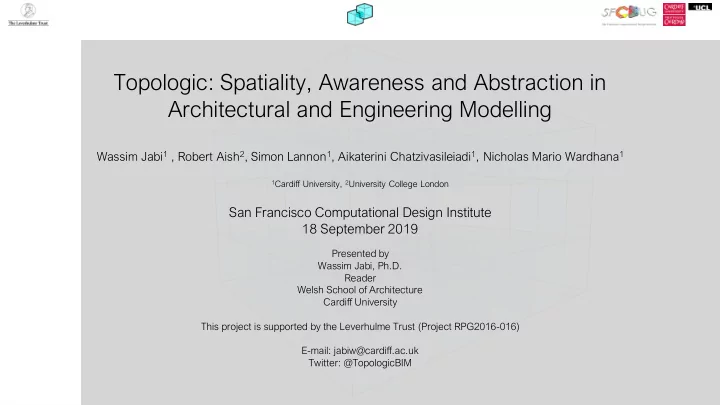

Topologic: Spatiality, Awareness and Abstraction in Architectural and Engineering Modelling Wassim Jabi 1 , Robert Aish 2 , Simon Lannon 1 , Aikaterini Chatzivasileiadi 1 , Nicholas Mario Wardhana 1 1 Cardiff University, 2 University College London San Francisco Computational Design Institute 18 September 2019 Presented by Wassim Jabi, Ph.D. Reader Welsh School of Architecture Cardiff University This project is supported by the Leverhulme Trust (Project RPG2016-016) E-mail: jabiw@cardiff.ac.uk Twitter: @TopologicBIM
Team
Team Short Biography Dr. Wassim Jabi earned his B.Arch. from the American University of Beirut and his M.Arch. and Ph.D. from the University of Michigan. While in the U.S., he led the Association for Computer-Aided Design in Architecture (ACADIA), secured a National Science Foundation (NSF) grant, and taught at various universities before moving to Europe in 2008. He is currently a Reader (tenured Associate Professor) at the Welsh School of Architecture, Cardiff University where he leads the digital design area. Dr. Jabi has published widely on topics ranging from parametric and generative design to the role of light in architecture and building performance simulation. He has been a member of the editorial board of the International Journal of Architectural Computing (IJAC). Dr. Jabi has written a book titled "Parametric Design for Architecture" (Laurence King Publishing, London). His current research is at the intersection of parametric design, the representation of space, building performance simulation, and robotic fabrication in architecture. Dr. Jabi has recently secured a significant grant from the Leverhulme trust to enhance the representation of space through non-manifold topology in parametric design environments. This resulted in a freely available software development kit titled Topologic (http://topologic.app).
Why Topologic? SPATIALITY AWARENESS ABSTRACTION
Spatiality
Awareness
Abstraction Source: Professor Gottfried Augnebroe. Presentation at the Welsh School of Architecture
Aggregation vs. Division
Manifold Geometry a collection of points forming a certain kind of set, such as those of a topologically closed surface or an analogue of this in three or more dimensions.
Non-Manifold Topology A non-manifold body also has a boundary [composed of faces] that separates the enclosed solid from the external void. Faces are either external [separating the interior (enclosed space) from the exterior (void)] or internal [separating one enclosed space (or cell) from another]. Furthermore, a non-manifold solid can have edges where more than two faces meet.
Use Cases Energy Analysis Structural Analysis Digital Fabrication (Conformal Cellular Structures) Spatial Reasoning
Multi-disciplinary Design Feedback Loops
Topologic Build, Connect, Analyse http://topologic.app
Topologic OPEN. MULTI-PLATFORM. FREE.
Topologic Model as Driver for Multi-disciplinary Analysis Topologic model Building Fabric Model Energy Analysis Model Structural Analysis Model Spatial Reasoning Model
Topological Queries
Dual Graph – Connect Through Shared Faces
Dual Graph – Shortest Path Hannah Ju
Content/Context and Custom Dictionaries
Topological Awareness • One CellComplex is the Result of a Cell being Imposed on a CellComplex • Exterior Vertical Faces are Yellow • Interior Vertical Faces that Separate Small Cells are Blue • Interior Vertical Faces that Separate a Small Cell from a Large Cell are Red • Horizontal Faces are Hidden.
TopologicalEnergy: OpenStudio & EnergyPlus
Geometric Optioneering with Refinery
WIP: FDS Fire Propagation
Reinforcement Learning
Machine Learning – Escaping a spreading fire
BuroHappold
Thank you. Wassim Jabi, , Ph.D. .D. Reader Welsh sh School of Architec ecture Cardiff Universi sity jabiw@card rdiff.ac.uk or info@to topologic.app Twitte tter: @topol olog ogicBIM http://to topol olog ogic.app
Recommend
More recommend